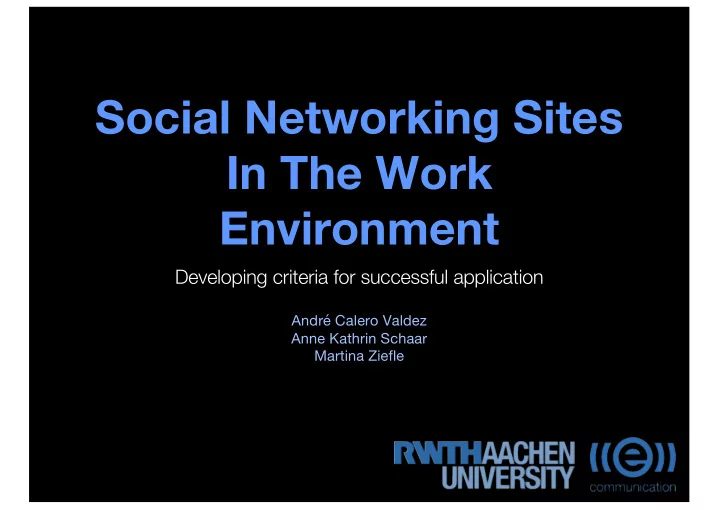

Social Networking Sites In The Work Environment Developing criteria for successful application André Calero Valdez Anne Kathrin Schaar Martina Ziefle
Agenda • Demographic change and changes in employment biographies • Social Networking Sites (SNS) • Two phase Study - Criteria for SNS
Agenda • Demographic change and changes in employment biographies • Social Networking Sites (SNS) • Two phase Study - Criteria for SNS
Demographic Change • Experienced workers who retire take their knowledge with them • In 2030 workforce size retirement age will shrink dramatically • Why is this a problem and how can we compensate for this loss?
Skill Shortage • retirement of baby boomers • changes in employment biographies - shift to project work - short-term contracting - temporary employment - parental leave
New Innovation Requirements • fast information interchange, resource allocation, training of new employees • conservation of business critical information • flexible working hours, international business relationships
Agenda • Demographic change and changes in employment biographies • Social Networking Sites (SNS) • Two phase Study - Criteria for SNS
What is a SNS? • For instance: Facebook • web-platform which allows users to connect each other • communication platform • allows group forming
SNS Benefits • SNS can be used to satisfy these new innovation requirements • conserve information (on the fly) • flexible worldwide access • support different ways of communication
SNS Usefulness • n - network size • value of the network: • Metcalf‘s law: n ² - all possible connections • Reed‘s law: c ⁿ - sub-networks multiply value • Dunbar‘s # - brain can handle 150 relationships • value depends on # of active participants
Get employees to use it!
Important Criteria • user diversity: age, gender, technical expertise • barrier‘s and motives like privacy, control, functional scope, relationship topology • percieved usefulness, percieved ease of use • How do people use SNS already?
Agenda • Demographic change and changes in employment biographies • Social Networking Sites (SNS) • Two phase Study - Criteria for SNS
Two Phase Study • qualitative focus group (n=10) • IT-related employees (ages 25-45) • high adoption of private use (i.e. Facebook) • important for SNS success were: • variety of communication media (IM, email, SNS) • depending on context of communication • voluntariness of use (in small organizations) • strong company policy (in big organizations)
Questionnaire • online survey with preselected target audience • independent variables • demographic data • company size and hierarchy position • private social media usage
Dependent Variables • amount of interaction with relationships (on-/offline) • media preferences for 10 scenarios • type of media: vis-á-vis, phone, mobile, texting, email, IM, SNS • context: with whom + topic
Results • n = 194 ( ♂ / ♀ =1), M age = 31.9 SD age = 9.9
Social Media Usage • Average # of relationships equal
♂ ♀ ♂ ♂ ♀ ♀ ♀ ♀ ♀ ♀ ♀ ♂ ♂ ♂ ♂ Social Media Usage • Women interact with bigger proportion of relationships • self-reported • p on <.01 p off <.05 • male online
♂ ♀ ♂ ♂ ♀ ♀ ♀ ♀ ♀ ♀ ♀ ♂ ♂ ♂ ♂ Social Media Usage • Women interact with bigger proportion of relationships • self-reported • p on <.01 p off <.05 • female online
♂ ♀ ♀ ♀ ♂ ♂ ♂ ♂ ♀ ♀ ♀ ♀ ♀ ♂ ♂ Social Media Usage • Women interact with bigger proportion of relationships • self-reported • p on <.01 p off <.05 • male offline
♀ ♀ ♀ ♀ ♀ ♂ ♂ ♂ ♀ ♀ ♀ ♂ ♂ ♂ ♂ Social Media Usage • Women interact with bigger proportion of relationships • self-reported • p on <.01 p off <.05 • female offline
Media Preference • with customers
Media Preference • with colleagues about private matters
Influence of Age • Age has a strong influence on SNS usage preference (older users = less SNS preference) • Age has a strong influence on private communication subordinates
Size and Hierarchy • bigger companies • use less texting, IM, SNS • communicate less often with their subordinates • communicate less often privately • employees that have a higher hierarchy position communicate less often in general
Conclusion • A SNS for the work environment should allow different media for different purposes. - „Call now“ button for customers - „Send text“ button for colleagues that are your friends • Bigger companies require more formalized means of communication along with informal means. • A SNS site must be able to reflect company hierarchies.
Thank you for your attention!
Recommend
More recommend